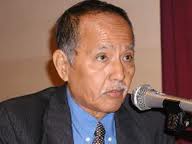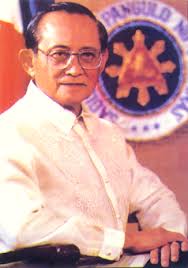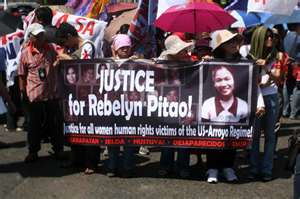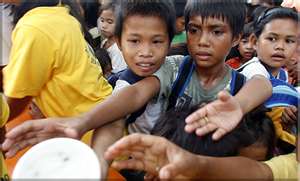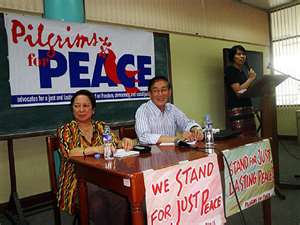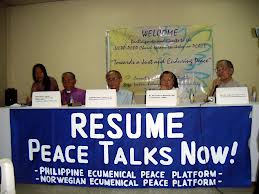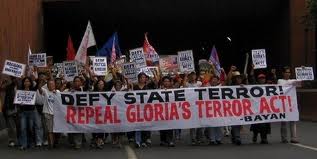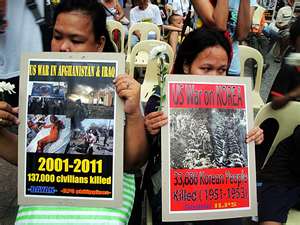by Atty. Marie J. Yuviengco
Introduction
The Southern Philippines Council for Peace and Development (SPCPD) has been hailed by both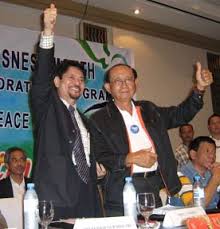 the GRP and the MNLF as the most concrete avenue for a political settlement of the 24-year Bangsa Moro armed struggle. While both camps are one in trumpeting the SPCPD as the facility within which Chairman Misuari and the Moro National Liberation Front shall lay down their arms and join the mainstream of society, some have raised serious questions about its nature, purpose and effective in finally and genuinely resolving the armed conflict in muslim Mindanao.
the GRP and the MNLF as the most concrete avenue for a political settlement of the 24-year Bangsa Moro armed struggle. While both camps are one in trumpeting the SPCPD as the facility within which Chairman Misuari and the Moro National Liberation Front shall lay down their arms and join the mainstream of society, some have raised serious questions about its nature, purpose and effective in finally and genuinely resolving the armed conflict in muslim Mindanao.
Some sectors say that through the proposed council, President Fidel Ramos has granted Misuari and the MNLF earth-shaking concessions that could undermine not only the presidency but also the sovereignty and territorial integrity of the entire nation. Others would say that Ramos has granted Misuari immese powers that threaten the alleged momentum of progress of southern Philippines and the SPCDP is an actuality a provisional government in disguise.
Still others maintain that the SPCPD is the best way of arriving at a conclusion to the armed struggle. So, why not give it the benefit of the doubt in order to give peace a chance?
Defense Secretary Renato De Villa dismisses the growing opposition to the SPCPD as simply a problem of information dissemination. While it is true that there indeed is a failure specifically on the part of the GRP to inform the public about the development in the GRP-MNLF talks, we should examine the nature and thrusts of these so-called opposition forces. The opposition basically comes from the following: the Roman Catholic Church hierarchy, local politicians, other Moro movements, lumads and other indigenous peoples and other political and liberation forces.
Will the opposition succeed in slaying the SPCPD? Some would observe that the opposition may not even be genuine. Of late, the tide of opposition is slowly but surely waning. As of August 2, 1996, as reported in the national dailies, a majority of senators have withdrawn their opposition to the SPCPD. The Catholic bishops have already expressed their support for it.
Analysts would say that the effect of most of the opposition is merely to push the MNLF to agree to the barest of concessions from the government.
On another score, the agreement on the SPCPD has opened the doors for legislators to resurrect their call to amend the Constitution. They have passed on first reading Resolution No. 23 which proposes to amend the charter through people’s initiative. The most vocal proponent of this move is Speaker Jose de Venecia of the Lakas Party who has time and time again tried to sell the idea of changing Charter. This raises suspicions that the same will be employed for a possible extension of the legislators’ terms and that of Ramos. This idea of extending Ramos’ term got the affirmative vote of Nur Misuari who has painted a picture necessitating Ramos’ presence as chief executive in order to assure peace and development in the South.
In the recent past, moves to perpetuate Ramos and his people in power have been strongly opposed by a wide range of political forces. Among the more significant attempts include: first, the shift to a parliamentary system of government. Then the threat of terrorism was dangled which would justify the declaration of martial law. And now comes the SPCPD.
If only for this reason, we cannot simply dismiss the SPCPD as it may be the subterfuge for the possible extension of Ramos’ grand and insidious designs to coopt revolutionary forces in the name of “peace and development”? A close scrutiny of its provisions is, therefore, in order.
The SPCPD: its Evolution
The MNLF’s original reason for being was lead the Moro people “towards the revolutionary path for the primary objective of re-acquiring the Bangsa Moro people’s political freedom and independence and settling themselves free from the clutches of Filipino terror and enslavement.” It became then a logical battlecry to fight for secession or “complete political independence and sovereignty”.
After the Kuala Lumpur Islamic Foreign Ministers Conference in 1974, Misuari and his group lowered their demand from “complete political independence” to “complete political autonomy”. The 1976 Tripoli Agreement is rife with provisions calling for such political autonomy.
Based on the sequence of events, the shift in the avowed goal of the MNLF was in all probability due largely to the pressure and influence of the Organization of Islamic Conference (OIC).
Several events ensued after the signing of the Tripoli Agreement which include, among others, the signing of a three-point agreement between Libyan President Muamar Khadaffy and President Ferdinand Marcos calling for the following:
1. Marcos would declare autonomy in the thirteen (13) areas defined in the Tripoli Agreement.
2. Marcos would form a provisional government for the autonomy in which members of the MNLF and the inhabitants of the areas covered by the autonomy may participate; and
3. The provisional government would hold a referendum in the areas of autonomy on the administrative arrangements “in accordance with Article XI (3) of the 1973 constitution.”2
To implement the accord, Marcos issued Proclamation No. 1628 which declared autonomy in Southern Philippines and held a plebiscite which resulted in the reduction of the original (13) provinces to ten (10) and creation of two autonomous regions.
This was viewed by the MNLF as a blatant violation of the Tripoli agreement which later resulted in the breakdown of the peace negotiations with the Marcos government. The violation stemmed not from the act of reducing areas of autonomy but more substantially because of the impotence of the law creating the autonomous government in Southern Philippines which essence puts the Lupong Tagapagpaganap and the Sangguniang Pampook under the control and supervision of the President.
Thereafter, President Corazon Aquino resumed peace negotiations with the MNLF immediately upon her assumption to office. At issue again was the question of autonomy. Aquino did a Marcos in the sense that she also held a plebiscite which resulted in the creation of the Autonomous Region of Muslim Mindanao (ARMM) through R.A. 6734 in four of the poorest provinces in Mindanao.
In October 1992, peace negotiations between the Ramos government and the MNLF were initiated. Misuari was summoned to the Libyan capital as there was a Manila contingent coming over. In Libya, the GRP formally asked the MNLF to discuss the possibility of resuming the talks. With the imprimatur of the OIC, Nur had the Manila contingent convey to FVR the MNLF’s readiness to return to the negotiating table, citing the fact that it was fully in accord with Islamic principles.
The following conditions were laid down by Misuari for the resumption of peace talks:
1. Negotiations should take place outside the Philippines and only in a neutral country;
2. Peace talks should be conducted under the auspices of the Organization of Islamic Conference, and
3. Peace talks must be devoted solely to seeking of modalities for the full implementation of the letter and spirit of the Tripoli Agreement.
Two weeks later, instead of proceeding with formal talks, the parties decided to engage in exploratory talks which led to the Cipanas talks in 1993.
The parties were able to forge an agreement indicating their desire to engage in the peace talks. Thereafter, they began formal talks and engaged in a series of committee meetings which spanned a period of four years until the 8th Mixed Committee Meeting in Davao City.
At issue now is the establishment of the Ramos version of autonomy in Muslim Mindanao. Did the Ramos Government, via the SPCPD, accede to the demands of the MNLF for political autonomy via a provisional government or autonomous government? Will the Ramos government give in to the demand of Misuari for “complete political autonomy”? Will President Ramos resort to the same process of holding a plebiscite?
The GRP-MNLF peace talks under the Ramos administration has produced several agreements namely, the 1993 Interim Cease-fire Agreement, the 1993 Memorandum of Agreement on the Formal Peace Talks and the 1994 and 1995 Interim Agreements and the Davao Agreement. There has been talk of a forthcoming agreement which is referred to as the “1996 Jakarta Agreement” which finally close the peace negotiations between the GRP and the MNLF.
General Alexander Aguirre of the GRP Negotiating Panel points out the following contentious issues which have remained unresolved in the duration of the four-year GRP-MNLF negotiations, to wit: “the details of the joining of the MNLF with the Armed Forces of the Philippines (AFP), the details of the establishment of the Special Regional Security Force (SRSF), the provisional government and the area of autonomy”.3
The main issue, Aguirre explains, is whether the establishment of a provisional government or transitional structure leading to a new autonomous government and the areas included therein necessitates the holding of a plebiscite. The MNLF maintains there is no need to do so, citing Paragraph 15, Article III of the Tripoli Agreement which stipulates that the establishment of a Provisional Government will take effect upon the simple expedient of signing the Final Agreement in Manila. The GRP, however, takes Paragraph 16, Article II of the Tripoli Agreement as basis for resorting to a plebiscite, to wit:
The Government of the Philippines shall take all necessary constitutional processes for the implementation of the entire Agreement.
But what does the term “constitutional processes” mean? In a paper entitled “GRP Panel’s Position: Meaning of term Constitutional Processes”, the GRP took the following position:
In sum, our constitutional processes mean:
1. Any agreement which runs counter to the provisions of the Constitution or goes beyond its framework, needs to go through the tedious process of amending or revising the Constitution, through a proposal made by a constitutional convention called by Congress or a proposal made by Congress itself acting as a constituent assembly or a proposal by people’s initiative; and approval or ratification of the proposal by a majority of the votes cast in a plebiscite conducted throughout the Philippines.
2. Any agreement which remains within the confines of the present constitutional provisions but which is inconsistent with the provisions of the Organic Act, requires an amendment of the Organic Act which provides specific procedures for its amendment or revision…
The Organic Act or the law creating the ARMM (R.A. 6734), on the other hand, can be amended or revised by the following acts:
1. By a majority vote of the House of Representatives and of the Senate voting separately.
2. The Regional Assembly by a vote of three-fourths (3/4) of all its members or by recalling for the Regional Consultative Commission to propose said amendment or revision. In any case, the approval of Congress is still necessary.
3. Said amendment or revision shall be effective only upon approval by a majority of the votes cast in a plebiscite called for the purpose to be held not earlier than 60 days nor later than 90 days from approval of such amendment or revision. 4
For the ostensible reason of trying to break the impasse, Aguirre suggested the creation of a transitional body called the Southern Philippines Commission on Peace and Development which later evolved into what is now known as the Southern Philippines Council for Peace and Development (SPCPD). 5
This SPCPD, in the Panel’s view, shall be created not by a plebiscite, but merely by executive action. But some quarters have taken the position that it should be created by Congressional legislation. This issue has already been resolved in the subsequent agreements.
The establishment of the SPCPD is fleshed out in a document containing 37 Points of Consensus arrived at by the 8th GRP-MNLF Mixed Committee Meeting with the Participation of the OIC Ministerial Committee of the Six on June 21-23, 1996 in Davao City which shall refer to here as the “Davao Consensus”.
The GRP-MNLF Panel is composed of five (5) Support Committees, namely:
1. National Defense and Regional Security Force
2. Education
3. Economic and Financial System, Mines and Mineral
4. Administrative System, Representation in National Government, Legislative Assembly and Executive Council
5. Judiciary and Introduction of Shariah Law.
These committees are tasked to examine all the relevant issues “in their respective areas of responsibility and submit their respective reports with the recommendations to the Mixed Committee.”6 The Mixed Committee, on the other hand, composed of “representative of the Central Government of the Republic of the Philippines and representative of MNLF”, is tasked “to study in detail the points left for discussion in order to reach a solution” in conformity with the Tripoli Agreement. (See Article III, Paragraph 11 of the Tripoli Agreement).7
The Points of Consensus
The establishment of the SPCPD is divided in to two (2) phases. The first phase, otherwise referred to as the transition phase or phase for the implementation of the Tripoli Agreement, runs for a period of three years. During this phase, a “Special Zone of Peace and Development” shall be established in the fourteen (14) provinces and all cities therein covered by the Tripoli Agreement out of Mindanao’s twenty-three (23) provinces and sixteen (16) cities. In the Tripoli Agreement, the following provinces are included: Basilan, Sulu, Tawi-Tawi, Zamboanga del Sur, Zamboanga del Norte, North Cotabato, Maguindanao, Sultan Kudarat, Lanao del Norte, Lanao del Sur, Davao del Sur, South Cotabato, Palawan.
There has been some debate as to whether Davao City should be included in the SPCPD. To this, Atty. Jose Lorena of the MNLF legal panel for the talks posited the MNLF position that Davao City is indeed included in the SPCPD. It has been countered, however, by the GRP Panel that this untenable. This is probably because at the time the Tripoli Agreement had been signed on December 23, 1976, Davao was no longer a part of the province of Davao del Sur. Thus, Davao, in the GRP’s understanding, could not be contemplated to be within the coverage of the SPCPD.
The first phase, in effect, involves those provisions in the agreement which would not require legislative action for its implementation; the second phase, on the other hand, would be reserved for those needing the appropriate legislative measures. In this sense, the question on whether the SPCPD should be created by executive or legislative action has been resolved.
Phase I
The council will be headed by the MNLF, with three deputies representing the Muslims, Christians and Lumads. There will be consultative assembly which shall be headed also by the Council Chair. This consultative assembly shall have eighty-one (81) members composed of the Governor and Vice-Governor for ARMM, the provincial governors and mayors of the areas covered and representatives of NGO’s and PO’s upon consultation with the MNLF. The Council will basically perform administrative responsibilities and perform such other functions as may be delegated by the President. The Consultative Assembly, on the other hand, shall be tasked to serve as advisers to the council and to a certain extent, formulate policies for the President.
What does this implication of the said powers and functions? It is clear that the Council shall merely perform a role of being the alter ego of the President. In this sense, the MNLF is strictly obliged to abide by the dictates of the President even if, for instance, this may ultimately run counter to the greater interests of the Moro people.
It is interesting to note that the Council shall also be empowered to “assist in the holding of elections, referenda or plebiscite and people’s initiative in the area deputized by the COMELEC upon recommendation by the President”. This is interesting because if we take the aforequoted provision together with Misuri’s pronouncement supporting the proposal to extend Mr. Ramos term, the stated powers may be conducive to manipulation and fraud in the electoral process.
Point No. 13 of Phase 1 deserves attention. It states: “The tenure of the Executive Council and the Consultative Assembly shall be for a period of three years and extendable by the President upon recommendations of the Council.” Strictly speaking, tenure refers to the period within which public official shall actually hold office. The absence of a “term” of office would, therefore, imply that the Council and Executive Assembly shall serve at the entire pleasure of the President.
Thus, it is clear that Phase 1 of the Davao Concensus is designed to provide a transitional mechanism toward the setting up of a new autonomous government, if they are lucky, particularly in overseeing Ramos’ so-called development efforts in the fourteen (14) provinces and nine (9) cities in Mindanao including Palawan.
Phase II
The Second Phase, otherwise referred to as the implementation of the “autonomous government”, will entail the amendment or repeal of R.A. 6734 through Congressional action. Said amendment or repeal shall be initiated within the First Phase of the SPCPD. During the Second Phase, a plebiscite will be held wherein the citizens residing within the proposed provinces and cities will decide whether they would agree to join the areas of autonomy. The holding of a plebiscite will determine:
a. The acceptability of the new ARMM law
b. The establishment of a new autonomous government
c. The specific areas of autonomy.8
The plebiscite curiously will be held in 1998 to coincide with the next Presidential elections. After the plebiscite, either of two scenarios may take place:
1. New areas of autonomy may be created if there are provinces/cities which would choose to form part of the autonomous regions;
2. No areas of autonomy at all will be created or, worse, the existing ARMM may even be diminished!
Misuari claims that “99% of the issues have already been done away with in the course of the three year talks” and what still needs to be done is to resolve the issue of the integrationof internal security forces. As to what particular aspect of security is still in contention, Misuari had occasion to state that the only major obstacle as to the integration issue is simply a question of “budget”!
In the remote possibility that a “new regular autonomous government” has been successfully established, a PNP Regional Command for the said area shall likewise be created and shall be called the Special Regional Security Forces (SRSF). 9
Any law governing the SRSF must be “consistent with the constitutional provision that there shall be one police force in the country which the is national in scope and civilian in character.”
There shall be SRSFs in the provincial, district, city and municipal levels. The SRSF shall be headed by the Provincial Director with the deputy each for the Administration and Operations. Provincial and District offices shall be headed by directors while city and municipal SRSFs shall be headed by a Chief of Police.
The Head of the Regional Autonomous Government shall also act as deputy of the National Police Commission (NAPOLCOM). A Regional Police Commission (REPOLCOM) shall also be created which shall likewise be under the NAPOLCOM.
Legal infirmities & obstacles
Already, there has been talk that the SPCPD is legally and constitutionally infirm.
Early on, Ramon Gonzales in his capacity as a taxpayer, filed a prohibition suit before the Supreme Court and questioned the constitutionally of the SPCPD. The SPCPD, he says, is violative of the constitutional provisions relating to the creation of an office or the disbursement of funds without legislative action.
It was noted further that the creation of an autonomous region under Section 18(2) Article X of the 1987 Constitution has become functus oficio with the ratification by four provinces of the law creating the Autonomous Region of Muslim Mindanao. 10
Another issue is whether of not Misuari can hold two concurrent positions in the government as head of the SPCPD and as Governor for the ARMM. President Ramos himself has given the opinion that such was untenable for in effect, Misuari would be holding not only two, but three different positions, namely, as SPCPD Chair, ARMM Governor and Consultative Assembly member. Of relevance,however, is the provision in the Organic Act of ARMM (R.A. 6734) which prohibits the governor from holding any other employment, if one can call the position as an employment. 11 To this, Chairman Misuari reveals the existence of a “deal” with the GRP which would allow him to old on the said positions at the same time. This could be the same package proposals MNLF spokeperson Rev. Absalon Cerveza mentioned which the Government presented to the MNLF in Jakarta on June 3-5, 1996. Misuari said:
…(T)his is all part of the deal. The government proposed to us that it should be a single leadership only, so we could guide institutions towards the direction we want. Without this single leadership, there is no guarantee that we would get things done the way we want them to be done. And besides, there would be demands from the other groups, other parties. This agreement makes it certain that the MNLF will dominate the South. 12
It is specifically agreed upon the Council shall be assisted by a religious advisory council or the Darul Iftah. This provision has been the subject of great concern especially from members of the Christian community and the Catholic church as well. Why we give the Darul Iftah a distinct role in the administration of the Council? Is it because the MNLF considers the struggle a religious war between Muslims and Christians? Or is it the very nature of Muslim culture, they consider Islam as the foundation upon which their society is instituted? Does this not violate the principle of separation of church and state?
Who is to Gain From this Agreement
Jose Maria Sison, chief political consultant of the NDFP Peace Panel, is of the opinion that “(S)everal states belonging to the OIC, which are pro-US and on which Nur Misuari has long depended,… have finally pressed upon him to surrender completely to the Ramos regime.”13 The OIC has continued to prod the MNLF into arriving at a political settlement of the Bangsa Moro struggle. This has been proven by their role in pushing the MNLF into agreeing to engage in peace negotiations from the Tripoli Agreement up to the present negotiations with the Ramos government. Misuari even admits that the Ministers “made efforts” to enable the two panels to reach at a compromise solution in the present talks. 14
Professor Sison suspects that “(t)he US is very much behind the Ramos-Misuari deal, especially because the US is interested in bases and in the oil resources in the Moro areas.” This suspicion is not without basis. Already, members of the City Council of Zamboanga have filed a resolution recommending the initiation of a study to invite the Americans to install their military bases in Mindanao.
At present, there are massive development projects being undertaken in Southern Philippines under the Brunei Darassalam, Indonesia, Malaysia, Philippines (BIMP-EAGA), SOCSARGEN and Mindanao 2000 programs. The following are worth mentioning:
1. The construction of a US-AID designed and funded international airport in General Santos City. This airport, covering 600 has. reservation area, has a 3,200 meter concrete paved runway which accommodate wide-bodied aircrafts at full load capacity.
2. the US-AID designed and funded expansion of the Makar Port which is strategically located in the northwest coast of Sarangani Bay. The Bay is about 16 kms. at its widest and is about 33 kms. long from its mouth entrance in the Celebes sea. The 10.11 has. wharf will again be expanded by reclaiming 3.9 has. As of 1978, the wharf has a docking length of 561 meters with a controlling depth of 8.9 meters which can accommodate berthing spaces for about seven vessels at a given time. 15
These investments coupled with heavy concentrations of large multinational firms and investments could very well indicate that a political settlement of the issue is would greatly benefit them.
What is clear, furthermore, is the categorical accession and subordination of the MNLF to the limitations imposed by the Government. This is exemplified by the following:
1. Resolution No. 18 at the Kuala Lumpur Conference in 1974 calling for the resolution of the Moro issue within the framework of the national sovereignty and territorial integrity of the Philippine Republic.
2. The following provisions in the Tripoli Agreement:
a. calling for “(t)he establishment of Autonomy in the Southern Philippines within the realm of the sovereignty and territorial integrity of the Republic of the Philippines.” 16
b. requiring the Government of the Republic of the Philippines to take the “necessary constitutional processes” for the implementation of the Tripoli agreement.
3. A declaration from the OIC to the effect that the MNLF struggle is an internal struggle and should, therefore, be resolved within the framework of local laws.
4. The entering into an “indifinite” ceasefire agreement with the government at or about the same time formal negotiations have started.
5. The following provisions in the Davao Consensus:
a. That “(t)he powers and functions of the SPCPD and the Consultative Assembly are derivative and extentions of the President.” 17
b. That “(t)he local government units in the area including the ARMM, shall continue to exist and exercise their functions in accordance with the existing laws.”
c. That the creation of additional administrative offices and instumentalities shall be with the “approval of the President and for budgetary purposes.” 18
Even as Mr. Ramos denies that the suspicions that the SPCPD was created in order to create a climate conductive for the entry of foreign investors from the Islamic countries and other capitalists nations to take advantage of the cessation of armed hostilities 19 he himself admitted the same by saying:
Continued conflict would mean to the international community lack of political will on our part and resultant loss of business confidence in effecting a just resolution of the plight of our Muslim countrymen and countrywomen. 20
These suspicions even become clearer when the Davao Consensus specifically makes mention of the drive for attracting foreign investments, to wit:
The Council, in consultation with the Consultative Assembly, utilizing the funds from the National Government, shall orchestrate the development efforts in the area, including the attraction of foreign investment, specially from the OIC countries and the ASEAN.
Conclusions
Is the SPCPD the correct framework for achieving peace and development in Muslim Mindanao?
The Moro people have long been marginalized in almost all aspects of governance, i.e. economically, politically and culturally. By giving Misuari a significant role albeit constrictive in scope, a semblance of significant and relevant participation is created.
Many would recommend the SPCPD formula for the Mindanao prolem. For after all, the same is a product of years and years of peace negotiations. The country, they say, is anxious for a change of climate in Muslim Mindanao and if only for that temporary respite, the SPCPD is worth trying out.
There is no guarantee that Misuari may get his autonomous government under the present terms. Too much burden is given to Misuari to realize it. Even if all the provisions of the present agreement are followed to the letter, ha may still come out of the exercise with nothing. When this arises, unlike in the breakdown of the talks with Marcos, Misuari can no longer cry foul as Misuari has placed his stamp of approval on each and every step of the process.
Most basic is the requirement of properly understanding the Moro problem in its entirety. If we fail to fully comprehend the problem, then most likely, we will fail in arriving at a most appropriate solution. This, we think, is the fundamental flaw in the creation of the SPCPD.
In essence, we venture to say that:
1. The SPCPD is but a continuation of the MNLF’s series of submissions to the pressures and dictates coming from the OIC and foreign governments beholden to monopoly capitalists interests which began from the Tripoli Agreement down to the SPCPD.
2. The SPCPD is a structure that may lend justification for the extension of Ramos’ term beyond 1998.
3. The SPCPD is a concession which will leave marginalized Moro community as the losers in this so-called process for peace and development.
4. The SPCPD is a grand scheme hatched from the highest levels of the reactionary government and not surprisingly with the collaboration of government foreign monopoly capitalist countries like the US and countries forming part of the OIC in order to satisfy their growing need for markets and natural and human resources.
5. The SPCPD does not address the fundamental problems of Bangsa Moro struggle and instead, supports the perpetuation of feudal relationships, the use by government functionaries of their power to pursue their economic interests and those of foreign monopoly capitalism.
The Ramos government may have succeded in winning over the MNLF into the mainstream. But this victory will have little effect on the fundamental problems and issues subject of the 24-year Bangsa Moro struggle. What government has succeeded in doing is simply to have diminished its oppositionists by one force. For once, I am in agreement with Gen. Alexander Agurre when he said the MNLF “will cease to exist as a revolutionary force” once Misuari accepts the offer to head the SPCPD. 21
By announcing his candidacy for the ARMM under a Lakas-MNLF alliance, Misuari admits that he has “totally rejected the armed struggle.” 22
The MNLF has, therefore, surrendered its principles, abandoned its struggle and embraced the line of the ruling elite. The MNLF is no longer a “liberation force”. The MNLF is now a political party whose only chance for survival is to embrace wholeheartedly the oppressive and repressive system of governance and for Misuari to engage in elitist politics. Thus:
… Over time, objective reality may dictate that MNLF will cease to be a ‘liberation front’ and transform itself into a political party. Then it will have its share of politicians and managers out of its commanders and security forces…23
What then the alternative? We believe that there is no short and easy road to peace. So long as the roots of social unrest and conflict remain, no genuine and lasting peace can ever take place. Palliatives can at times even make matters worse.
Misuari claims that “(P)eace is now very near, if not, already in the offing”24 but we in the Public Interest Law Center believe that there can be no fundamental change if reforms are made within and under the framework of a reactionary system/state, as is the case at hand.
Notes
1 See “Understanding Armed Political Movements, The Quest for Moro Self-Determination”, p. 55, citing Misuari, Rise and Fall of Moro Statehood.
2 See Satur C. Ocampo, “Bangsa or Muslim Autonomous Regions”, Notes for a lecture to commemorate the Jabidah Massacre of March 18, 1968. Davao City, March 19, 1996, at page 6.)
3 See Secretary Alexander Aguirre, 5th Draft Working Paper on the Transitional Structure and Implementing Mechanism Re: GRP-MNLF Talks, May 9, 1996.
4 See Article XVIII Sections 1-3 R.A. 6734.
5 See Secretary Alexander Aguirre, 5th Draft Working Paper on the Transitional Structure and Implementing Mechanism Re: GRP-MNLF Talks, May 9, 1996.
6 See GRP-MNLF Memorandum of Agreement of November 7, 1993, Jakarta.
7 See Article III, paragraph 11 of the Tripoli Agreement.
8 See Point No. 16 of the Davao Consensus.
9 See Point No. 17.
10 See Atty. Allan Tan, “Hopes and Fears: On the Mindanao Peace Processes”, June 30, 1996.
11 See Section 14, Article 8, of the Organic Act.
12 See Jomar Kho Indanan, “Only MNLF can Guarantee Peace, Interview with MNLF Chairman Nur Misuari”, Today, July 21, 1996.
13 See Jose Maria Sison, Press Statement “On the Ramos-Misuari Deal”, July 11, 1996.
14 See Misuari’s videotaped speech, June 28, 1996.
15 See SOCSARGEN, PDI, July 3, 1996.
16 See Article 1 of the Tripoli Agreement.
17 See Point No. 7
18 See Point No. 15(6)
19 See Rolly A. San Juan and PDI Mindanao Bureau, “Gov’t MNLF agree on war reparations”, PDI, July 17, 1996.
20 See Carolyn O. Arguillas, PDI, August 1, 1996, citing FVR’s speech delivered before the graduates of the National Defense College.
21 See Ben Blin Gregorio, “Mindanao Talks: No Deal”, p. 1, Today, June 23, 1996.
22 See Jomar Kho Indanan, “Only MNLF can Guarantee Peace, Interview with MNLF Chairman Nur Misuari”, Today, July 21, 1996.
23 Dean Merlin Magallona, “Peacemaking: Issues and Themes in Perspective”, June 1996, General Santos City.
24 Misuari, Nur, “The Ongoing Challenge”, Speech on the occasion of a roundtable discussion on the Mindanao Peace Process, Peacemaking:, General Santos City, June 28, 1996.

